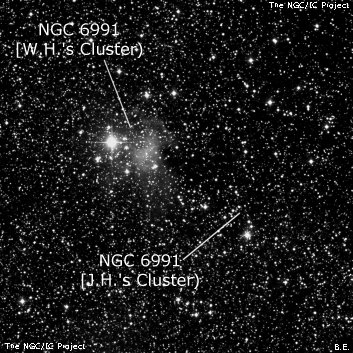NGC/IC Project Restoration Effort
(This is a very very beta version)
NGC6991


Basic Information
Location and Magnitude
Right Ascension: 20:55:39.0
Declination: +47:26:54
Constellation: CYG
Visual Magnitude:
Historic Information
Discoverer: Herschel W.
Year of discovery: 1788
Discovery aperture: 18.7
Observational
Summary description: Cl, L, P, vlC
Sub-type: OCL
Corwin's Notes
=====
NGC 6991. WH and JH saw two different clusters; JH mistakenly included them
in GC under a single number. Dreyer, of course, followed GC for the NGC.
I've included both in the table, so you get to choose which one you want.
Here are the stories to help you along:
In the sweep, WH describes his object as "6 m not in Fl[amsteed]. A L star
surrounded with many considerable stars, forming a brilliant though much
sc cluster; the star 6 m is not in the center, but towards the following
side." His position is a couple of arcmin south of the bright star, but there
is no mistaking the group that he saw. There is also some nebulosity on the
preceding side of the cluster, but it is faint enough that neither of the
Herschels saw it. Unfortunately, WH gives us no further information about the
size of the cluster he found. This could be important; more below.
JH has two observations of his cluster, which is smaller, fainter, perhaps a
bit richer, and southwest of his father's. The first from 14 September 1829,
reads, "A star 11 m. The last of that magnitude in an irregular triangular
cluster 6' diameter; poor and straggling." His second, from his next sweep,
says simply, "A star 9 m; the largest of a cluster." His positions are
significantly different, but point pretty accurately to the stars he mentions.
The 11th magnitude star is nearer the east side of the cluster, while the 9th
magnitude star is at the southwest apex of his cluster. That cluster,
well-defined by JH, is clearly not the one that his father found.
Choose one if you wish. I'll take both.
In October of 2005, I had the following email from Tony Flanders at Sky and
Telescope:
Sue French and I have been discussing NGC 6991, which she described in the
October 2005 issue of Sky & Telescope (page 71). As you note on the NGC/IC
website and she notes in her article, this could refer to either of two
clusters, one discovered by William Herschel and one by John Herschel.
There's not much doubt about JH's cluster. But I believe that the NGC/IC
website has mis-identified WH's cluster.
The notes (both yours and Steve Gottlieb's), together with the position and
size data and the illustration at the top of the "Public Database" page,
imply that WH's cluster is the concentration of stars in and around the
nebulosity IC 5076. But it's hard to believe that this tiny collection of
faint stars (illustrated on page 72 of Sue's article) would have been
described by WH as "a brilliant scattered cluster."
Sue and I both believe that Brent Archinal identified WH's cluster correctly
in "Star Clusters" (pages 106 and 189) as a much larger group, about 25' in
diameter, centered around 20:54.9, +47:25. As usual, it's hard to say
exactly which stars are in the group, but I'm attaching a sketch of Sue's
showing the "cyclops" that she describes in her article.
I replied:
You folks could well be right. But given the size of WH's field -- 15
arcmin -- and the magnifcation he used while sweeping -- 157X -- I think his
object is more likely to be the more compact 12 arcmin x 8 arcmin cluster
that is embedded in the nebulosity. My reading of his description seems to
indicate this as the probable object, too (but you knew that already ... :-)
However, since WH gives us no indication of size (this may also have been
what threw JH off), your argument has considerable merit. If you don't
mind, I'd like to quote your note above in my notes and offer it as a third
choice for the NGC object. This may be one of those cases where we won't be
able to reach a definite conclusion, but both interpretations should
certainly be aired. Then, observers can decide for themselves.
Checking Brent's note in Star Clusters, I find that he's quite adamant about
his interpretation. As you might have gathered, I'm rather doubtful. So, the
position Brent gives is in the table, but with a question mark on the
identity.
See also NGC 7011 where JH's object here provides some support for the
identification of the later cluster.
Steve's Notes
=====
NGC 6991
17.5" (10/24/92): at John Herschel's position and matching his description for h2091 is a scattered group of approximately 20 stars in a 6' field which is located about 10' SW of IC 5076 and a mag 5.7 star. Three equal mag stars are collinear on the east side and a mag 8.5 star is on the SW side. There are no dense knots or a core and this collection of stars barely stands out in the field.
At William Herschel's original position and description (VIII 76) is a scattered group of stars involved with IC 5076 and mag 5.7 SAO 50246. Nebulosity (IC 5076) is visible on the west side of a striking 5' group of stars centered on the bright star. Ten of the stars surrounding the mag 5.7 star form a semi-circle including a tight quadruple 2' SE. John Herschel's h2091 lies ~10' WSW and either object could be taken for NGC 6991.



